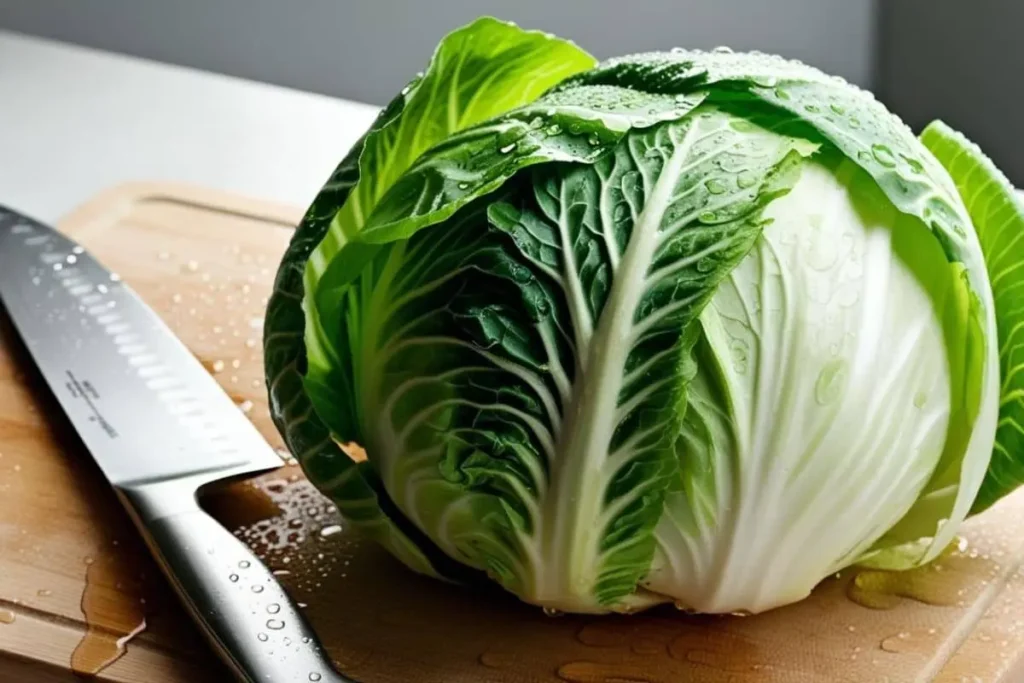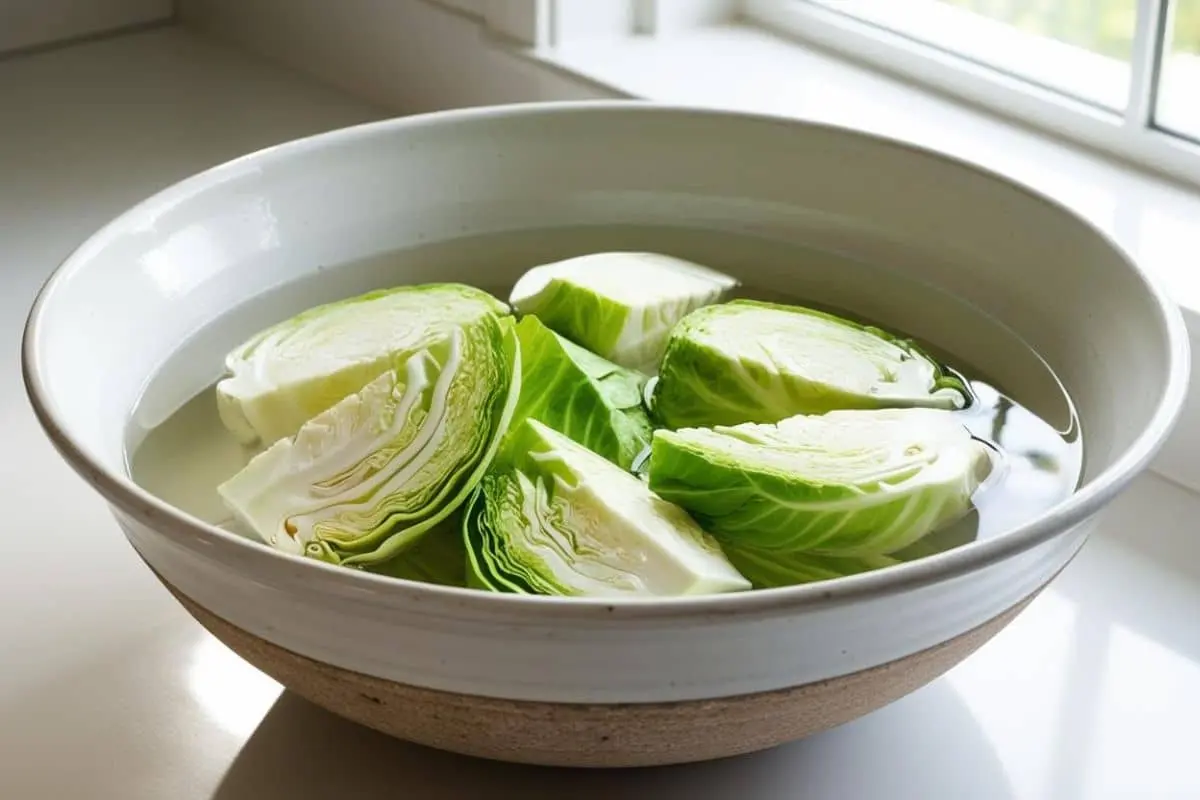When it comes to cooking cabbage, a seemingly simple vegetable, you might have heard this advice: soak it before you cook it. But why? Does it really make a difference? Let me tell you it absolutely does! From cleaning out dirt to making it taste better, soaking cabbage is a small yet powerful step that transforms your dish. Let’s dive into the reasons behind this common cooking practice and figure out how you can do it like a pro.
The Simple Step That Makes a Big Difference
Ever bite into a cabbage dish and think, “Hmm, something’s off”? Maybe it was gritty, a bit too bitter, or even chewy. That’s where soaking comes in to save the day. This underrated step is like prepping a canvas before painting. It ensures the cabbage is clean, flavorful, and ready to absorb all the goodness of your spices, sauces, or dressings. Whether you’re making slaw, stir-fry, or stew, a quick soak can be a game-changer.
What Happens When You Don’t Soak Cabbage?
Let’s address the elephant in the room: Do you really have to soak cabbage? Well, technically no, but skipping this step could lead to some annoying issues. Here’s why:
Common Issues with Unsoaked Cabbage
- Dirt and Grit: Cabbage grows in layers, and dirt can sneak into those folds. No one wants a surprise crunch of dirt in their meal!
- Bitter Taste: Fresh cabbage can sometimes taste bitter, especially if it’s not cleaned properly.
- Hidden Bugs: Yep, little critters might be hiding in there. Soaking helps evict these uninvited guests.
“Not soaking cabbage is like skipping sunscreen on a beach day you might get away with it, but you’re taking unnecessary risks!”
Why Do You Soak Cabbage Before Cooking? Key Reasons
Soaking cabbage isn’t just about cleanliness it’s about setting the stage for a delicious meal. Here’s why you should make it a habit:
1. Removing Dirt and Impurities
Cabbage leaves can trap dirt, especially closer to the stem. Soaking loosens the grit, making it easier to rinse off.
2. Reducing Bitterness for a Milder Taste
Sometimes, cabbage can taste a little harsh. Soaking helps draw out some of the compounds responsible for bitterness, giving it a sweeter, more neutral flavor.
3. Softening the Texture for Easier Cooking
Ever notice how cabbage takes forever to soften in a stew? Soaking preps the leaves, making them more pliable and easier to cook evenly.
4. Eliminating Pesticides and Other Residues
Even if you buy organic, there might still be traces of pesticides or other residues. A good soak in cold water can help remove these.
5. Removing Insects Hidden in the Layers
Okay, it’s gross, but true tiny bugs sometimes hide in cabbage leaves. A soak ensures they float out before they end up on your plate.
How to Properly Soak Cabbage Before Cooking
So, how do you do it? Don’t worry it’s super easy! Follow these simple steps:
Step-by-Step Instructions for Soaking Cabbage
| Step | Instructions |
|---|---|
| 1. Remove the Outer Leaves | Peel off the first few layers—they’re often damaged. |
| 2. Cut or Separate the Leaves | Quarter the cabbage or separate the leaves for thorough cleaning. |
| 3. Fill a Bowl with Cold Water | Use cold water to preserve crispness and prevent wilting. |
| 4. Add a Splash of Vinegar | Optional but recommended—it helps with bugs and bitterness. |
| 5. Soak for 10-15 Minutes | Let the cabbage rest in the water while the magic happens. |
| 6. Rinse and Pat Dry | Rinse thoroughly under running water and dry with a clean towel. |
“Think of soaking cabbage as giving it a mini spa day clean, refreshed, and ready to shine!”
Best Practices for Cleaning Cabbage Thoroughly
- Use a colander to rinse the cabbage under running water after soaking.
- For extra grit, gently rub the leaves with your hands while soaking.
- Don’t forget to check the crevices near the stem this is where dirt and bugs love to hide.
Do All Types of Cabbage Need Soaking?
Not all cabbages are created equal, so let’s break down whether your cabbage needs a soak:
Green Cabbage vs. Red Cabbage
Green cabbage is the most common type and definitely benefits from soaking, especially if it’s been sitting on a store shelf. Red cabbage, on the other hand, is less likely to have hidden bugs but still has a waxy coating that soaking can help remove.
Napa Cabbage and Savoy Cabbage
These are more delicate and often have fewer issues with dirt or bugs. A quick rinse might be enough, but a short soak won’t hurt.
Cabbage for Fermenting (Kimchi or Sauerkraut)
If you’re fermenting cabbage, soaking is crucial to remove any unwanted bacteria or residues that could interfere with the fermentation process.
Common Problems When Soaking Cabbage
Even a simple task like soaking cabbage isn’t completely foolproof. Here are some common hiccups and how to avoid them:
1. Over-Soaking and Losing Crunchiness
Leaving cabbage in water for too long can make it soggy. Limit soaking time to 15 minutes to preserve that perfect crunch.
2. Does Soaking Cabbage Remove Nutrients?
A minor concern for health enthusiasts: soaking can cause some water-soluble vitamins (like Vitamin C) to leach out. However, the loss is minimal if you don’t over-soak.
3. Dealing with Waterlogging in Cabbage
If your cabbage feels waterlogged after soaking, pat it dry with a clean kitchen towel or let it sit in a colander for a few minutes before cooking.
Solutions for Soaking Issues
If you’ve run into trouble while soaking cabbage, don’t worry you’re not alone. From over-soaking to unnecessary nutrient loss, these small setbacks can happen. But the good news? They’re all fixable! Let’s tackle these common problems and explore solutions that make soaking cabbage a seamless part of your cooking routine.
1. How Long Should You Soak Cabbage?
Timing is everything. A quick soak of 10-15 minutes is usually enough to clean the cabbage, soften it slightly, and reduce any bitterness. For leafy varieties like napa or savoy, even 5 minutes will do the trick. If you’re in a rush, a fast rinse can work, but remember it’s not quite as thorough.
2. Alternatives to Soaking: When to Skip It
Sometimes, soaking isn’t strictly necessary. If your cabbage looks clean and you’re short on time, you can simply rinse it under cold running water. For tightly packed cabbages like green or red varieties, peel off the outer leaves to remove any dirt or contaminants and then rinse the rest.
“If soaking feels like overkill, think of it as optional housekeeping. You wouldn’t skip vacuuming entirely, but a quick sweep does the job sometimes!”
3. Quick Fixes for Busy Cooks
Short on time but still want clean, flavorful cabbage? Try these shortcuts:
- Pre-cut cabbage: If you’re using pre-shredded or pre-cut cabbage from the store, a quick rinse is all you need.
- Saltwater rinse: Sprinkle a little salt in your soaking water to help dislodge grit faster.
- Kitchen hack: Use a salad spinner to speed up the drying process after soaking.
Benefits of Soaking Cabbage for Specific Recipes
Not all cabbage recipes are created equal. Soaking can play a bigger or smaller role depending on what you’re cooking. Let’s explore how soaking cabbage impacts different dishes:
1. Preparing Cabbage for Salads and Slaws
For raw dishes like coleslaw, soaking is essential. Why? It helps reduce bitterness and ensures a clean, crisp texture. Nobody wants a gritty bite in their fresh salad, right? After soaking, dry the cabbage thoroughly to prevent your slaw from becoming watery.
“Think of soaking cabbage for slaw like polishing a mirror every bite reflects the care you put into the dish!”
2. Soaking for Stews, Soups, and Braises
When cooking hearty dishes like cabbage soup or braised cabbage, soaking helps remove any hidden dirt and gives the leaves a softer texture that cooks more evenly. This is especially helpful when using dense cabbage heads, as the inner layers can hold onto grit.
3. Enhancing Fermentation Results with Proper Cleaning
For fermented dishes like kimchi or sauerkraut, cleanliness is non-negotiable. Soaking helps ensure no residual pesticides, dirt, or bugs interfere with the fermentation process. Plus, it softens the leaves slightly, making them easier to pack tightly into jars.
Cultural and Traditional Practices Related to Soaking Cabbage
Believe it or not, soaking cabbage has deep roots in culinary traditions worldwide. Let’s take a quick tour of how different cultures incorporate this step into their cooking:
1. Asian Cooking Techniques with Cabbage
In many Asian cuisines, cabbage is a key ingredient in stir-fries, soups, and pickles. For example, in Korea, soaking cabbage is an integral step when preparing kimchi. The process not only cleans the leaves but also preps them for the salt rub that follows.
2. European Approaches to Cleaning and Prepping Cabbage
In Eastern Europe, cabbage rolls (sarma or golumpki) are a beloved dish. Before rolling, the cabbage leaves are often soaked or blanched to soften them for easier wrapping. Similarly, for dishes like German sauerkraut, soaking ensures a clean base for fermentation.
3. Modern vs. Traditional Methods
While traditional methods emphasize thorough soaking and cleaning, modern cooks often rely on pre-washed or shredded cabbage for convenience. However, taking a little extra time to soak your cabbage can elevate your dish, making it taste fresher and more authentic.

Conclusion: The Importance of Soaking Cabbage
At this point, you’re probably thinking, “Is soaking cabbage really that important?” The answer is yes if you want clean, flavorful, and perfectly cooked cabbage every time. This simple step is like setting the foundation for a house. Skip it, and you might end up with something unbalanced or flawed.
Final Tips for Making the Most of Your Cabbage
- Always adjust soaking time based on the cabbage type more time for tightly packed varieties, less for loose-leaf types.
- Don’t forget to pat the cabbage dry, especially for raw dishes like slaws or salads.
- For an extra boost of freshness, add a splash of vinegar or lemon juice to the soaking water.
“Great cooking starts with great prep and soaking cabbage is one of those small steps that lead to big results.”
Encouragement to Experiment with Cabbage Soaking
Now that you know the why, how, and when of soaking cabbage, it’s time to try it yourself. Whether you’re whipping up a colorful slaw, hearty stew, or zesty kimchi, a quick soak can make all the difference. Go ahead show that humble cabbage some love. 🥬✨

